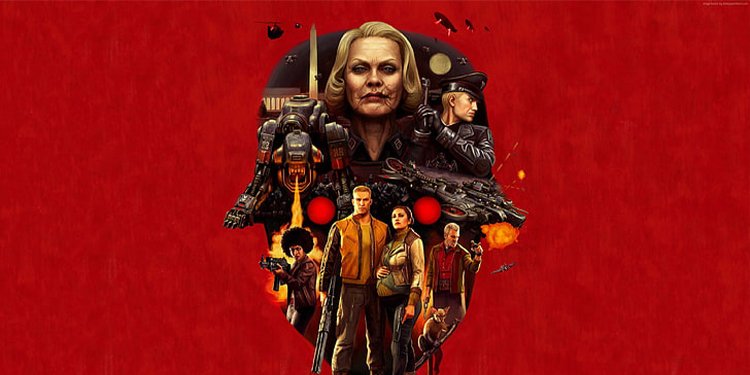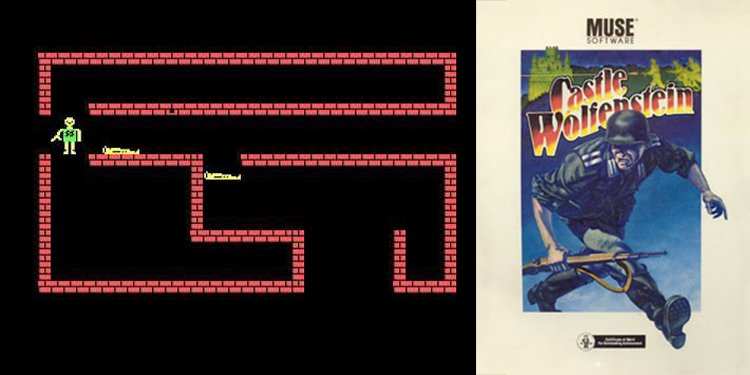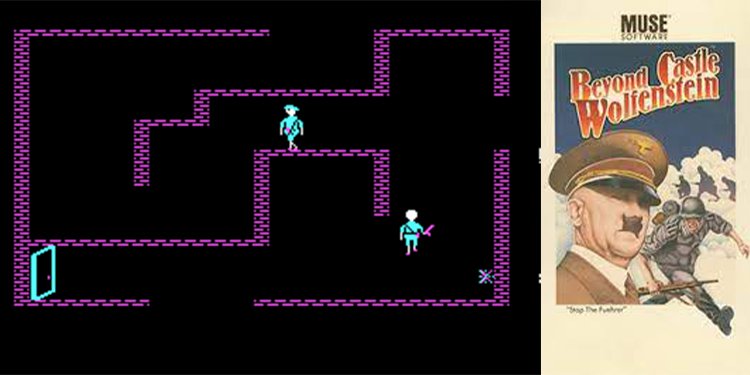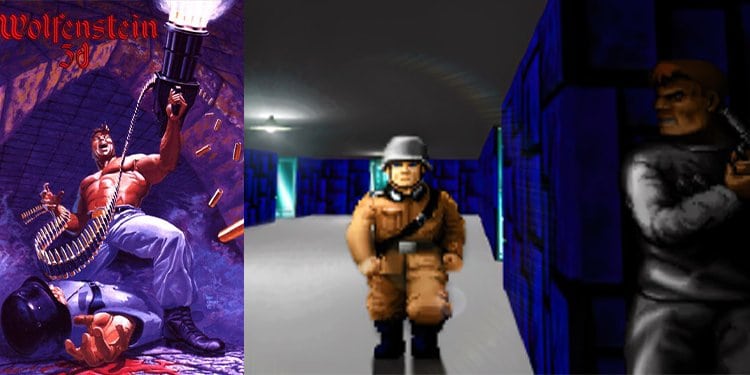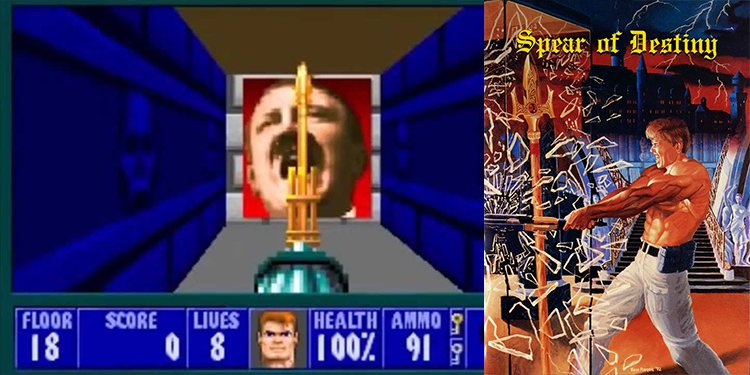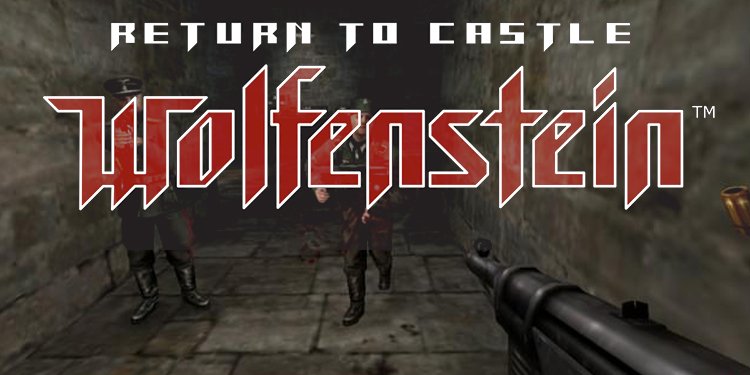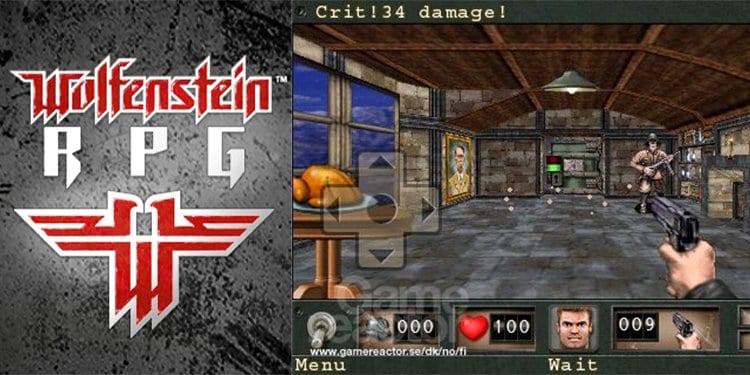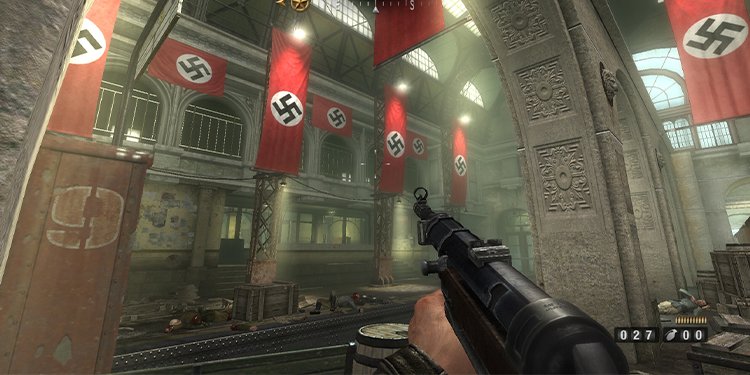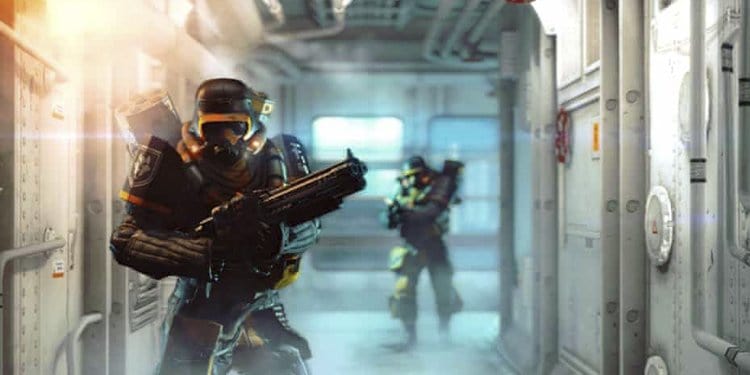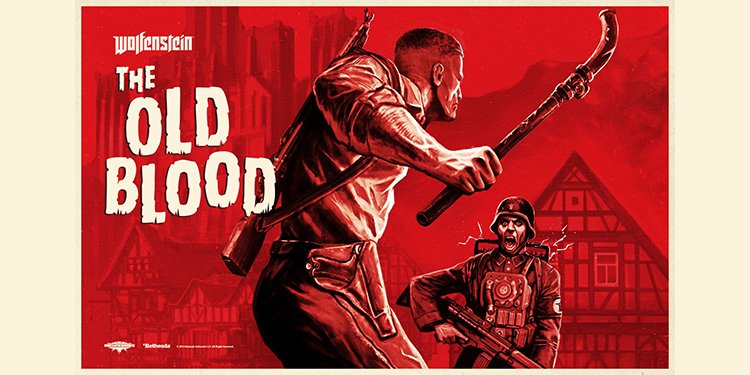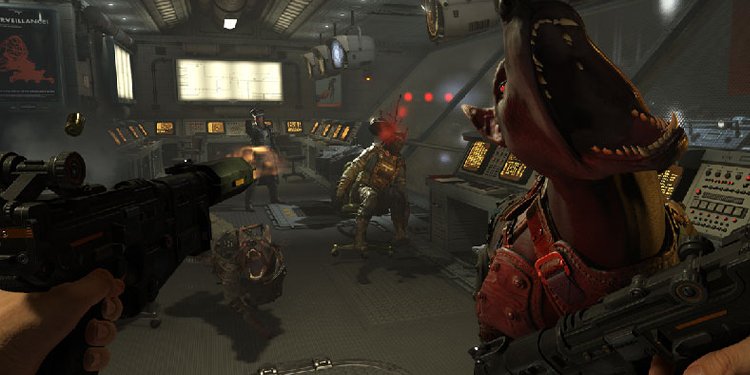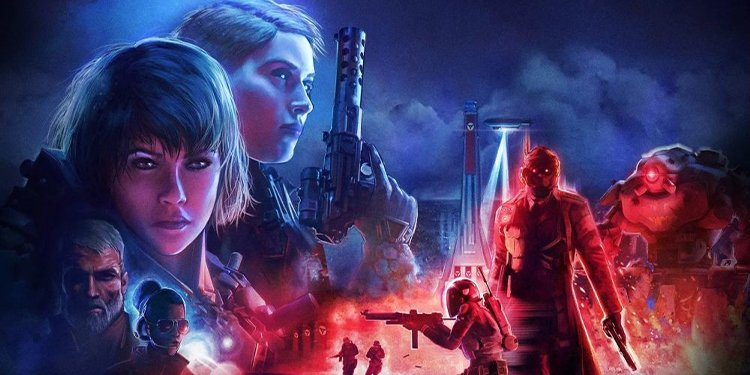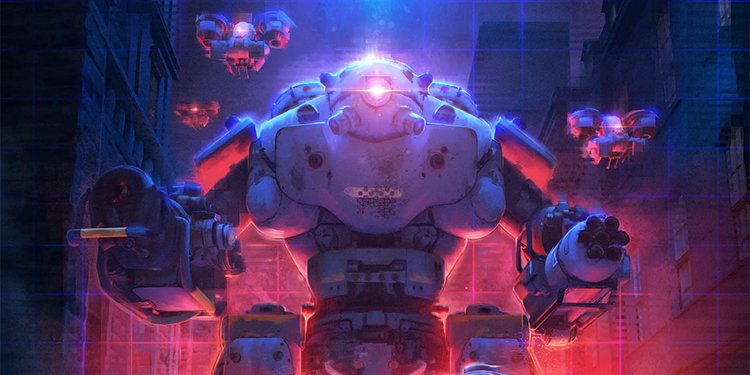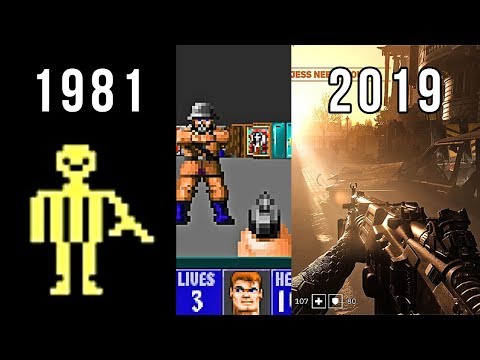Muse Software created the title, but iD Software brought it back from the forgotten past. They also changed the formula from a stealth-based top-down FPS to a fast-paced first-person shooter.Much like the Doom saga, Wolfenstein is known as one of the names that popularized the FPS genre. Because of how the series shaped the shooter genre, we’re looking at the 13 Wolfenstein entries.
The Wolfenstein Series
The first era of the series went through 1981 and 1992. Muse Software took care of the series during the first saga. They created the concept from the 1961 war film “The Guns of Navarone.” The movie follows an Allied commando through a lethal German fortress. American programmer Silas Warner took the idea and turned it into a shoot ’em up arcade video game. Soon, they created “Castle Wolfenstein.” Video-game critics credit the title as the “grandfather of FPS.”The second era went through 1992 and 2001. iD Software took the series in a new direction right after they founded the company in 1991. Following new ideas, the studio remade Wolfenstein into a 3D FPS.However, their series wasn’t commercially successful, which led to the third era (2001 -2009). Multiple have taken the Wolfenstein series towards different genres with varying success. iD Software was the executive producer, whereas Activision was the publisher.Lastly, there’s the fourth era. After ZeniMax bought iD Software, the latter gave MachineGames the rights to Wolfenstein. Then, under Bethesda Softworks (part of ZeniMax), we saw the modern games of the series.
Muse Software Era
Castle Wolfenstein – 1981
Muse Software launched Castle Wolfenstein in 1981. It was an action-adventure game for the Apple II home computer. The gameplay came with a 2D top-down perspective. It’s an arcade shooter featuring stealth combat. That said, it’s one of the first games with stealth mechanics. Similarly, it was the first computer game with digitized speech.Its plot happens during WWII. The player controls an Allied war prisoner, escaping from Castle Wolfenstein. After breaking out of the cell, the protagonist has to find the Nazi’s secret war plan.In essence, you play through a series of mazes. The goal is either reaching the exit or killing the enemies. You can sneak, or you can shoot. Lastly, you have to find bullets and keys across the maps.
Beyond Castle Wolfenstein – 1984
Beyond Castle Wolfenstein debuted in 1984 for the Apple II home computer, the Commodore 64, MS-DOS systems, and the Atari. The sequel brought very similar gameplay. You play through various levels in a secret Berlin Bunker. Meanwhile, Adolf Hitler is holding secret meetings with his senior staff, somewhere near you. The goal is to put a bomb near the Fuhrer. Like the previous game, you can sneak through the levels or combat. Therefore, it’s a stealth-based side-scroller.
iD Software Era
Wolfenstein 3D – 1992
iD Software re-made Wolfenstein into a 3D first-person shooter genre. Its historical significance is due to how it took the genre right to mainstream audiences. The studio released the game in 1992 for DOS systems. It was a shareware title under Apogee System’s publishing. The plot follows Allied spy William “B.J.” Blazkowicz during WWII. He needs to escape from a Nazi German prison complex, Castle Wolfenstein. Nevertheless, he needs to steal Nazi documents on the way out.The game goes across a series of 3D mazes. The goal is finding the exit, often an elevator, until defeating the final boss. The enemies are Nazi soldiers and dogs. And the arsenal includes a variety of guns and knives.Lastly, the game included a UI that details the Floor level, the score, Lives, Health, ammo, and equipped gun. That said, every asset takes from the same engine as the original Doom titles, so these games are very alike.
Wolfenstein 3D: Spear of Destiny – 1992
Wolfenstein 3D’s sequel debuted in 1992 for DOS PCs. FormGen Corporation was the publisher, and they chose not to release the title as shareware. It continues Blazkowicz’s story with similar gameplay as before. The title follows the protagonist as he’s looking to retrieve the stolen Spear of Destiny from the Nazis. This is a legendary weapon that grants an immeasurable power to its wielder. The gameplay doesn’t change significantly. However, the story doesn’t come in chapters as before. Instead, there’re 21 levels, but two of them are secret. In 1994, iD Software released two new missions: “Return to Danger” and “Ultimate Challenge.” Cult followers name these chapters “The Lost Levels,” as not many people know its existence. Yet, the publisher released the base game plus the extra episodes as “Spear of Destiny Super CD Package.”
iD Software as Executive Producers Era
Return to Castle Wolfenstein – 2001
Return to Castle Wolfenstein debuted in 2001 for Windows, Linux, Macintosh, PlayStation 2, and Xbox. Gray Matter Interactive and Nerve Software were the new developers, whereas Activision became the publisher. Notably, none of these studios had (or have) any significant experience. Simply, these developers were tied to the Call of Duty franchise. Yet, iD Software became the executive producer and, together, they created an influential title. The 2001 game was an FPS through and through. You play through a large maze (a castle) with the mission of sabotaging and assassinating. Combat allows stealth elimination, sneaking, shooting, and looting armor. Enemies vary from undead, experimental creatures, and soldiers. Lastly, the plot continues with B.J. Blazkowicz as he investigates the German SS Paranormal Division.It also had a multiplayer aspect, which became its most popular feature. The game mode is about two teams (Axis and Allies) trying to complete a set of opposing goals. Each team had classes, access to abilities, and special weapons. As a result, they became the first FPS game to feature a class system.
Wolfenstein: Enemy Territory – 2003
Enemy Territory was 2003 free and open-source FPS multiplayer. Its open-source code came from Splash Damage, once again under Activision publishing.This title has no storyline and no single-player. Instead, the multiplayer expands on the Allies vs. Axis idea. Each team defends or destroys objectives.Enemy Territory had six official maps based on real WWII locations. The gaming community has also created hundreds of maps, weapons, and tweaks.Lastly, the title had classes available. On top of that, players could earn experience points in various skill categories. Then, players could use the points to learn skills.
Wolfenstein RPG – 2008
Wolfenstein RPG debuted in 2008 for mobile phones and in 2009 for iOS. iD Software created the title, and Fountainhead Entertainment distributed the entry.The formula mixed FPS elements with role-playing features. The gameplay is akin to Doom RPG, also a mobile game. You played in first-person, but combat and movement were turned-based.The plot follows “B.J.” once again. The Nazis captured the hero, and it’s up to him to escape from The Tower and defeat the German Paranormal Division.
Wolfenstein – 2009
Raven Software created the 2009 Wolfenstein game. It debuted for Windows, PlayStation 3, and Xbox 360. Once again, Activision was the publisher, and iD Software was the executive producer.The game had a poor commercial performance. It sold less than 100,000 copies, so it was the final Wolfenstein under iD Software supervision. Also, ZeniMax Media had bought iD Software, so they moved on to other projects.Either way, the game follows the usual protagonist on a quest to find a supernatural medallion. The setting is deep below a Nazi mine below the fictional town of Isentadt.The gameplay was standard. It was a linear FPS across a series of levels against Nazi soldiers and inhuman creatures. However, it added various sci-fi weapons and horror elements to spice up the formula.
MachineGames / Bethesda Softworks Era
Wolfenstein: The New Order – 2014
The New Order debuted in 2014. Machine Games was the new developer, and Bethesda Softworks became the publisher. The title debuted for Windows, PS3, PS4, Xbox 360, and Xbox One.Its plot happens in the 1960s. It’s an alternate storyline where the Nazis won WWII. Still, the story follows the prior protagonist to stop the Nazis from ruling the world.Gameplay-wise, it’s an FPS where you navigate a series of levels. As usual, you can sneak, stealth-kill, shoot, and look. There’s also a cover system, new to the series. For novelties, the game has a morality system. Your choices may alter the storyline or alter the alternate and main timelines.Fans and critics received the game with positive reviews. Overall, it has a nice narrative, great combat gameplay, and graphics that still stand. Many years later, it still conserves a loyal fan base.
Wolfenstein: The Old Blood – 2015
The Old Blood is a prequel to the previous game. It debuted in 2015 for Windows, PS4, and Xbox One. Machine Games and Bethesda Softworks is the duo behind the game. For their second try, they added horror elements to lean the series into survival horror. This title follows an alternate story in 10946. The campaign follows Blazkowiccz trying to discover a Nazi compound. The war has ended, though, and the Nazis were victorious.Its gameplay is similar to the title before. It’s an FPS with action-adventure elements where you play through a series of linear levels across various chapters. Also, the campaign has two parts, and the climax revolves around a dark ancient power and a Nazi archaeologist.Overall, the title has intense firefights, an otherworldly storylñine, and intriguing action set-pieces. It also balances stealth, action, and narrative very well.
Wolfenstein II: The New Colossus – 2017
The New Colossus debuted in 2017 for PS4, Windows, Xbox One, and Nintendo Switch. MachineGames is the developer, and Bethesda Softworks is the publisher.Colossus follows “B.J.,” once again, fighting the Nazi regime in the United States. The game happens five months after The New Order and deals with the aftermath of the previous story.Its gameplay continues the trend. It’s an FPS shooter happening across various levels and chapters. There’re binary choices in the prologue, though, and these may alter the game’s storyline.Lastly, the game increases the number of weapons and enemies. As before, the protagonist can dual-wield some of these weapons.
Wolfenstein: Youngblood – 2019
Youngblood debuted in 2019 under MachineGames and Arkane Studios. As both developers belong to Bethesda, the latter published the game. It debuted for Google Stadia, Windows, Nintendo Switch, PlayStation 4, and Xbox One.The plot is 20 years after The New Colossus. America and much of the world are free from Nazi control. Meanwhile, B.J. Blazkowicz is living happily with his wife and daughters. It’s 1980, and the protagonist disappears without a trace.This setting delivers two new protagonists: Jessie and Zofia, BJ’s twin daughters. The girls set out on a journey to find their father after stealing an FBI helicopter and powered armor from a hidden cellar.Soon, they follow BJ’s trail to Neu-Paris. Here, the player controls either Jessie or Zofia on a similar FPS entry. There’s also an optional co-op campaign mode or just playing with an AI partner.Another novelty is how the game is not linear anymore. Players can play the missions they choose and unlock gear and abilities as the game goes on. This happens from the game’s hub, the sister’s base of operations.It’s one of the most unique series, yet the execution is not well refined. Hence, it got a mixed reception.Notably, the game lacks a critical update. Previous Wolfenstein games featured a simplistic AI. Youngblood is no different, even though it’s a modern game. As a result, stealth becomes incredibly easy.
Wolfenstein: Cyberpilot – 2019
MachineGames and Arkane Studios launched Cyberpilot in 2019. It’s a VR shooter available for PlayStation 4 VR and Windows (HTC Vive and Oculus Rift) for PS4 and Windows.The story presents a new protagonist, 20 years after The New Colossus and a week before Youngblood. You play in first-person as a Cyberpilot, a computer hacker working against the Nazi Regime in France. In essence, you control a fully-armed robot across several levels and against hundreds of Nazis.
Every Wolfenstein Game in Chronological Order
Gameplay Evolution
Even though the series hasn’t had the best success, Wolfenstein has added several features to the FPS genres. Also, it’s great seeing how the games have improved over the years. It feels like seeing the evolution of video games as a whole.
Why Did iD Software Leave the Wolfenstein Series?
Wolfenstein 3D and Spear of Destiny are the only games in the saga by iD Software. Because the first was shareware, and developers made Destiny’s code open-source by 1999, multiple ports are available.Over the years, these games reached Windows 98, SNES, Jaguar, Classic Mac OS, Apple IIGS, Game Boy Advance, Xbox, Linux, Xbox 360, PlayStation 3, iOS, and Android. Yet, the sales were always below iD’s Doom and Quake sagas, so they abandoned the IP.

